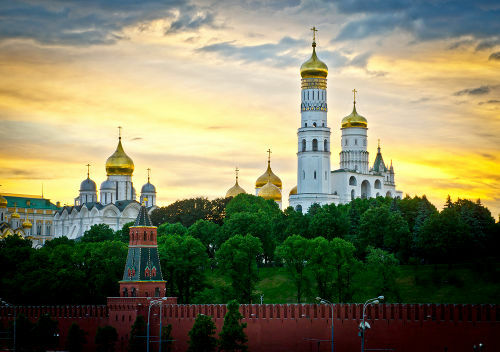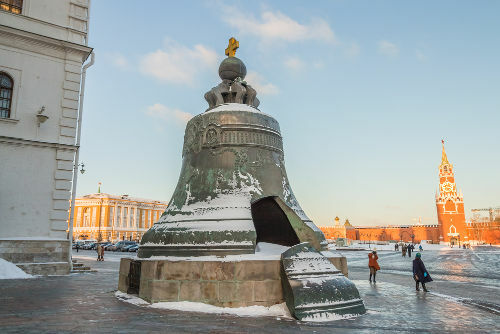Moscow it is Russia's capital and largest city, with approximately 12.3 million inhabitants. Economic and political center of the country, Moscow it is also one of the main tourist centers in Russia, attracting millions of tourists from different parts of the world every year. O Kremlin Moscow is the main one in all of Russia (there are in all about 20 Kremlins in Russia).
Kremlin History
The Kremlin is primarily known for being the home of russian presidents since 1991 (year the Soviet Union fragmentedup and Russia emerged as an independent nation). The history of the Kremlin, however, goes back many years and is directly linked to the founding of the city of Moscow in the 12th century.
Historians point to 1147 as the founding year of the city of Moscow, as the first mention of the city in historical documents was made on that date. The mention of Moscow happened in Russian chronicles in which YuryDolgoruky, a prince of the Rurik Dynasty, from the Principality of Kiev, invited Svyatoslav Olgovich to a festivity in the city.
Although this is the first mention of Moscow, some historians point to the fact that the founding of Moscow happened before 1147, however, there is no documentary evidence to support this argument. The Kremlin emerged shortly thereafter, in 1156, and was built by order of Dolgoruky himself.
The translation for the word Kremlin is “fortress within a city”, which basically represents what the Kremlin actually was in its construction. Dolgoruky ordered the construction of the Kremlin to protect the city from attacks by foreign peoples. The construction of the Kremlin was only completed by his son, who was called AndreyBogolyubsky. The structure of this fortress was oak.
With the arrival of the Mongols in the Moscow region, the Kremlin was destroyed in 1237 and was only rebuilt in 1339, again with a wooden structure. During the government of DmitryDonskoy in what was known as Grand PrincipalityinMoscow, the Kremlin structure was replaced, and the wooden walls were rebuilt with limestone between 1366 and 1368.

The largest tower in the entire Kremlin complex, the Belfry of Ivan III or Ivan the Great
The structure of the Kremlin walls was rebuilt between 1485 and 1495 during the reign of Ivan III (still in the period of the Grand Principality of Moscow). In addition, new towers were built under the influence of Italian architects, who had been invited by Ivan III himself. One of these towers was known as Ivan III's Belfry, the tallest tower in the entire Kremlin complex, with a total height of 81 meters.
New structures were built in the Kremlin complex during the reign of Ivan the Terrible (Russian ruler from 1533 to 1584). The big change that took place during this period was the definitive separation of the Kremlin complex from the rest of the city. With the beginning of the Russian Tsar, the Kremlin was the home of the Tsars until the reign of Peter the Great in the 18th century, when the capital was transferred to Saint Petersburg.
In 1812, with the invasion of Russia by the French by order of Napoleon Bonaparte, the Kremlin was invaded by French troops, who found the city of Moscow practically empty (before that, the Kremlin had been invaded by Poles during the 17th century). As there were not enough resources in the city to support the soldiers and as winter approached, the French retreated. Before, they tried to destroy the Kremlin, but only one tower was damaged.
In 1918, the Russian capital was again transferred to Moscow because of the rise of the regime. bolshevik. During the Soviet period, the Kremlin underwent further changes and, atop two towers of the Kremlin, two red stars – symbols of the Soviet regime – replaced the two eagles with two heads that stood on top of these towers. Eagles were symbols of the ancient Russian Empire from the time of the tsars. The placement of the stars took place in 1937.
Today, the Kremlin is one of the main tourist attractions in Moscow, and the entire Kremlin complex contains museums, churches, historic buildings and the Grand Palace, which is allowed to enter upon the purchase of tickets. The State Palace is allowed to enter by appointment, and the president's residence and some administrative buildings are not open for visitation.

The Tsar Cannon is over 400 years old and weighs over 40 tons
The wall surrounding the Kremlin has 2,500 meters long, and its height varies from 5 to 19 meters high. The largest tower, as mentioned above, is 81 meters high. Altogether, the Kremlin has a total of 20 towers. Some objects on display inside the Kremlin receive a lot of attention, such as the Tsar's bell it's the Tsar's Cannon (The word “Tsar” is a derivation of “Czar” and has the same meaning).
Both the bell and the cannon are the largest of their kind in the world. O Tsar's Cannon it was built in 1586 (thus it is over 400 years old) during the reign of Tsar Theodore I. The caliber of this cannon is 890 millimeters, it weighs around 40 tons in total, and each bullet weighs more than 800 kilos. Historians know that this cannon was used at least once throughout its existence, although they do not know when.

The Tsar's Bell weighs over 200 tons and was built in the 18th century.*
already the Tsar's bell it was built in 1730, therefore, in the 18th century, by order of Empress Anne of Russia. Unlike the cannon, which has been used at least once over time, the bell has never been used (however, a digital simulation of what it would sound like has already been done). In all, the bell is over 6 meters high and weighs an incredible 202 tons.
*Image credits: John_Silver and Shutterstock
By Daniel Neves
Graduated in History
Source: Brazil School - https://brasilescola.uol.com.br/historia/predios-historicos-moscou-kremlin.htm


